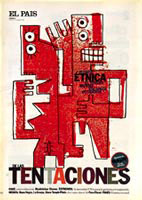Take the bull by the horns
Spanish design came to worldwide attention back in the 1980s. Now, twenty years later, a new crop of talent is displaying both flair and fantasy, according to Sara Manuelli

In the 1980s, Spanish design burst on to the international scene, culminating with the fanfare of the Barcelona Olympics, a ray of sunshine and fantasy that swept across an otherwise recession-struck Europe. But has the sun set on the Spanish design horizon since those dizzy heights of 1992? Well, it may be in the shade, but Spanish design is ticking along nicely and holding on tight to its visual and cultural heritage.
Any visitor frequenting the pavilions (there are now two more) of the Valencia furniture fair this year, would have thought they were in a mini Milan, with the accompanying chatter of design journalists, a plethora of side events and showroom openings, and competitions judged by the likes of Erik Spiekermann for graphic design and Matthew Hilton for furniture. Sales are also up, with figures for 1999 revealing that Spanish furniture sold in Britain makes up for 37 per cent of Spain’s total furniture export figures. Importantly, it is in London that you can spot most of the Spanish furniture: the GE Club private member bar at Terence Conran’s Great Eastern Hotel features leather armchairs from Andreu World, the Royal Opera House has seating from Akaba and the Wallace Collection Café Bagatelle chairs are by Bonestil.
Ian Mcready, business development manager for London retailer Coexistence, is a habitual visitor to the fair. “This year has seen fewer launches [than in the past], with the main companies aiming at the international market and fairs like Cologne and Milan,” he says. But Mcready has found designs to snap up – among his favourites are new products from Perobell, Andreu World and Punt Mobles, plus the amended range from Stua, which will all be available at Coexistence from March 2001.
Yet young Spanish names with international resonance are few, with British perception of Spanish design still tied up to established names such as Studio Mariscal and Jorge Pensi. London-based furniture trio El Ultimo Grito and Peugeot/ Oxo Design Award winner Hector Serrano may be Spanish, but because of their location, they have fallen easily under the young British design banner. Hilton, who judged this year’s International Furniture Design Competition in Valencia, says the standard of the winner was “pretty good”. He mentions BD Ediciones and Santa & Cole as his favourite manufacturers, although when asked about bright young sparks, he admits new blood has been somewhat lacking in the past years.
On the graphic design front, things look a bit rosier. Pentagram’s new partner, Fernando Gutiérrez, David Ruiz, Enric Aguilera, Bis Dixit, OMB and Ipsum Planet are all graphic design consultancies that are making themselves a name within and beyond Spain. London-born Gutiérrez worked as an associate at CDT Design – before moving to Barcelona in 1993 to set up what has become a well reputed design group, Grafica, with Pablo Martin. London based again from this month, he is well placed to comment on the current Spanish situation.
“Spain is made up of autonomous states and the way it’s organised is pretty competitive,” explains Gutiérrez. “The regions are self-governed and very proud. That’s the one success of Spain, it has very strong regions. Madrid is strong because it’s the capital, but the Basque Country has Bilbao, Valencia in the region of the same name, Seville and Malaga in Andalucia, and each region has their own language, their own identity and way of working,” he says. Gutiérrez chose Barcelona as a base because of its cosmopolitan outlook, good life and beach. But it’s in Madrid that Grafica found its main clients, such as the National Museum Arts Centre Reina Sofia, the bank Caja de Madrid, fashion magazine Vanitad and El Pais – designing its weekly supplement Tentaciones. Gutiérrez is also behind Matador, an annual magazine published with ex-El Pais managing editor Alberto Anaut, and in the words of Gutiérrez, “a space for photographers, writers and ideas”.
Design in Spain is a far cry from a homogeneous front. Mariano Lopez Ibor, designer at Madrid-based design consultancy OMB, confirms the divisions and explains the various cities’ outlooks. “Culturally, Barcelona is a city that has always been preoccupied by the image it gives and its design. Two of the best design schools are in Barcelona. Being in the North, Barcelona has always been more open to Europe. Valencia [on the other hand] is the other city where design is important, meaning also industrial and furniture design. In Valencia students can attend good schools.”
Yet Gutiérrez bemoans the lack of valid training. “You don’t get proper tuition, most designers are self taught.” It was different in the late 1970s, he says. “Because of the transition from Franco to democracy, people were much closer, there was more going on creatively. There were good filmmakers, interesting products, and a really broad range of good design,” he says. He cites graphic designer Daniel Gil and his book jacket work for publisher Alianza Editorial as one of his favourite old masters. Of the old guard, he rates Valencia-based Paco Buscu”án and Manel Granell of mythical group La Nave.
While based in Spain, Gutiérrez has enjoyed working with European clients such as Colors and Hermes. “I have been able to look at Europe from the inside, not just from an English perspective,” he says. Like other Europeans, he sees a unified Europe as an exciting place, a free market, a way of sharing ideas, products and creativity. A common theme mentioned by many of the designers interviewed here is the intention to free yourself from the restrictions of geographical barriers and take that design discourse beyond nationalities. Thanks to technology and an increasing notion of fragmented national identity, this dream seems to be possible. We profile here a mix of established and rising talent who are setting the Spanish scene.
-
Post a comment



